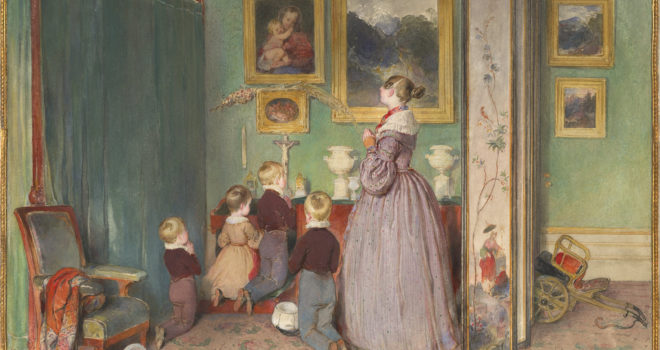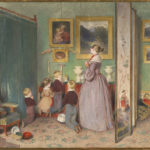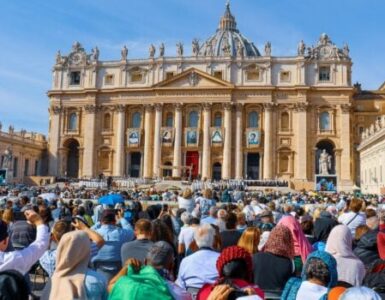So, you have a red leather-like Christian Prayer book, or the abridged version Shorter Christian Prayer, or someone bequeathed you the four-volume set, and you’re one of the many who has tried to figure out how to pray the Liturgy of the Hours yourself—and found it’s easier said than done. This convoluted way of prayer is best learned by praying together with people who already know how!
Instead of a normal book you could use a smartphone or tablet app, or you could order Word On Fire’s monthly booklet-format Liturgy of the Hours. And in all honesty, if you want to hit the ground running one of those may be the way. But what if you want to pray alone with the breviary (Liturgy of the Hours book) you already have?
I want to suggest that Night Prayer, a.k.a. Compline, is the easiest point of entry for learning on your own. If you later want to learn Morning and Evening Prayer you’ll grapple with quite a few more variables, but will build on what you can master while praying Night Prayer.
I’m going to explain for the person praying alone, but it can also be ideal for spouses. Unlike for the other hours that require you to find your bearings in the liturgical calendar and in a 4-week cycle of psalms, all you need to know to get on schedule for Night Prayer is what day of the week it is—though it helps to know that “After Evening Prayer I on Sundays” means Saturday night.
Pray Night Prayer just before bed, even if you go to bed at 2 a.m. Being determined to do so always even when you are tired, out of love for Jesus, is how you create the habit. Try to keep the book where it will be handy at bedtime. I do pray the other hours too so I have a breviary that permanently lives in my backpack, while I have a separate Night Prayer book at my bed. That way each book is always where I will need it.
Traditionally all liturgy is vocal prayer, even in private. Actually saying the prayers in a low voice can help keep your mind focused. In practice you may read silently, especially, of course, if you would be distracting or disturbing others. All of the text you are meant to say will be printed in the same standard black font. Text printed in bold, red or italic letters is not part of the prayer.
Standard editions of the Liturgy of the Hours don’t print the full beginning of the prayer before every individual “hour”—and that usually throws the self-instructed person off their stride right from the start.
Night Prayer goes like this: begin by standing up (unless doing so is too inconvenient or indiscreet), and make a big Sign of the Cross as you begin the prayer: “God, come to my assistance. Lord, make haste to help me. Glory to the Father, and to the Son, and to the Holy Spirit: as it was in the beginning, is now, and will be forever. Amen. Alleluia.” Notice well, the doxology (the “Glory to the Father”) is translated slightly differently than it is for the Rosary. We always say it that way for the Liturgy of the Hours. And just like in the Mass, we omit “Alleluia” from the Divine Office during Lent.
Keep standing! Next, as an integral part of the prayer, there is a little span of silence to examine your conscience for the day that’s ended. Even moreso than the opening words, this helps me to remember the presence of God. As in the penitential rite of the Mass, humility and contrition are the right way to become open to God in prayer. His nature is Mercy.
After the examen comes a hymn. Whereas an opening hymn at Mass is technically optional, the Liturgy of the Hours opening hymn is a true part of its structure. There are official hymns in the original Latin edition but their English translations can be difficult to sing (The Mundelein Psalterhas them as well as chant tones for the psalms). Therefore, the commonly used breviaries provide us with hymns that came from Mass hymnals; Christian Prayer is the only one of the Catholic Book Publishing Company breviaries that includes musical notation for those hymns. Feel free to pick a suitable hymn you know. It’s acceptable to just recite the words. Substituting an appropriate Catholic poem is even an option.
Now, sit down. The core of the Liturgy of the Hours is praying the Psalms. Night Prayer has fewer psalms than other hours. We’re tired, so it feels merciful to pray just one psalm. On Wednesdays and Saturdays there are two psalms.
Each psalm has an antiphon, which is key for the beginner to understand: first say the antiphon, then pray the psalm, then optionally make a healthy brief pause for silent reflection on the psalm you just said, then say the doxology, “Glory to the Father, and to the Son, and to the Holy Spirit, as it was in the beginning, is now and will be forever. Amen” (no Alleluia). Then, even though some of the books only print the antiphon before the psalm, we must say the antiphon again. The antiphon bookends each psalm. The repetition of the antiphon seems meant to interrupt our linear procession toward the next thing, to help keep us in a reflective attitude, continuing to think of what we are saying and to Whom we are saying it.
Next there is a (very) short Scripture reading (never prefaced with any words of introduction), followed by a short responsory. You say and linger with the words Jesus says to His Father from the Cross: “Into your hands, Lord, I commend my spirit.” One of the comforting and profound things about Night Prayer is that it can be understood as a spiritual preparation for both sleep and death through contrition and trust in God, which makes of bedtime a kind of peaceful rehearsal for a moment we can’t anticipate the timing of but which we want to live well.
Like the “hinge hours” of Morning and Evening Prayer, Night Prayer then includes a Gospel Canticle. Stand up—like you stand for the Gospel at Mass. The Gospel Canticle has an antiphon and a “Glory to the Father” which work the same way as with the psalms. Your book does not remind you to make a big sign of the Cross but it is a part of the liturgy to do so as you begin to say the words of the Gospel, from the old man Simeon as he holds the infant Messiah Jesus in his arms: “Lord, now you let your servant go in peace; your word has been fulfilled: my own eyes have seen the salvation which you have prepared in the sight of every people: a light to reveal you to the nations and the glory of your people Israel.” I often think with gratitude of gazing upon the same Jesus in the Eucharist.
Night Prayer finishes with a Concluding Prayer, the Sign of the Cross and “May the all-powerful Lord grant us a restful night and a peaceful death. Amen.”
Lastly, pray an “antiphon of the Blessed Virgin Mary” of your choice, which can be the Hail Mary, or, especially on Saturdays, the Hail, Holy Queen, or another fitting traditional prayer to Our Lady.
Rest well in the peace of Christ!
✠
Image: Peter Fendi – The Evening Prayer, 1839 [public domain].










